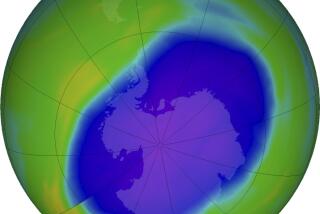Propellants Confirmed as Cause of Hole in Ozone
- Share via
WASHINGTON — The mysterious hole in the ozone layer over Antarctica is caused by a chemical reaction involving chlorine from gases used as propellants and refrigerants, scientists confirmed Thursday.
The chemical reaction is possible only in the presence of polar clouds, composed of tiny ice crystals, and the amount of sunlight that reaches the South Pole area in the late winter and early spring, scientists wrote.
The light pattern and the polar clouds, present during wintertime, explain why the hole appears between late August and mid-October--springtime in the Southern Hemisphere, they said.
“It’s only recently we began looking at ice particles as possible participants,” said Mario Molina, an atmospheric chemist at the California Institute of Technology’s Jet Propulsion Laboratory in Pasadena.
Described in Papers
The complex reaction was described in separate papers in the journal Science by Molina and colleagues and another team at Stanford Research Institute International in Menlo Park.
The scientists based their conclusions on data from an expedition to Antarctica.
Ozone is the only gas in the atmosphere that filters out harmful amounts of ultraviolet radiation from the sun. Estimates endorsed by the Environmental Protection Agency say that for every 1% reduction in ozone in the global atmosphere, there could be 20,000 more skin cancer cases annually in the United States.
The chlorine comes from chlorofluorocarbons, widely used as refrigerants in air conditioners and freezers, spray-can propellants in many parts of the world and in the manufacture of plastic foam insulators and containers such as those used at fast-food restaurants.
The compounds make their way into the stratosphere six to 30 miles high, where most of the ozone is located. Ultraviolet light breaks down the chlorofluorocarbons, starting the complex reaction.
Chlorine Molecules Formed
Two resulting compounds, hydrogen chloride and chlorine nitrate, normally do not react with one another, Molina said--but in the presence of ice in the polar clouds, they form molecules of chlorine. These molecules absorb light and break apart into single chlorine atoms known as free radicals, which rapidly destroy ozone.
Molina said the reaction occurs in the early spring because of a complex interaction between light and weather patterns.
Scientists had three theories for the appearance of the ozone hole, the chlorine theory being one of them. The other two blamed the phenomenon on sunspots and weather patterns alone.
“The data absolutely rule out the sunspot theory,” said David M. Golden, director of chemical kinetics at Stanford Research Institute International, and indicate that although meteorology plays a key role it is not the only explanation.
More to Read
Sign up for Essential California
The most important California stories and recommendations in your inbox every morning.
You may occasionally receive promotional content from the Los Angeles Times.












